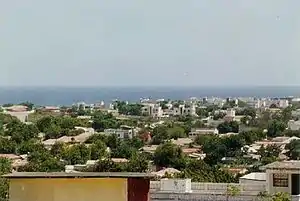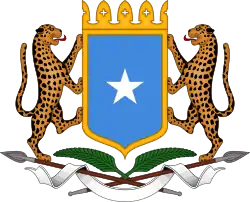Lower Juba
Lower Juba (Somali: Jubbada Hoose, Arabic: جوبا السفلى, Italian: Basso Giuba) is an administrative region (gobol) in southern Somalia.[3] With its capital at Kismayo, it lies in the autonomous Jubaland region. It has green forests and wild life animals such as lions, giraffes, hippos, crocodiles, and hyenas.
Lower Juba
Jubbada Hoose Basso Giuba | |
|---|---|
 Overview of Kismayo. | |
 Location in Somalia. | |
| Coordinates: 0°26′N 41°36′E | |
| Country | |
| Regional State | |
| Capital | Kismayo |
| Population | |
| • Total | 267,000 [1] |
| Time zone | UTC+3 (EAT) |
| HDI (2017) | 0.292[2] low · 13th |
Lower Juba is bordered by Kenya, the Somali regions of Gedo, Middle Juba (Jubbada Dhexe), and the Somali Sea. The province is named after the Jubba River that passes through it and empties into the Somali Sea at Goobweyn. The Lag Badana National Park is situated in Lower Juba.
History
However, in the latter half of the 20th century, A very few Darod families started to settle in Kismayo city. By the turn of the 20th century, as a guest, they had established a small business centres. In the beginning of the Somali civil wars, Kismaio known as Waamo faced a massive destruction among the faction leaders mainly between Hawiye and Darod each claiming the ownership of the Lower & Middle Juba regions. But on the other side, the city subsequently evolved economically into a major hub of the livestock trade.[4] The main Harti representatives to establish themselves in Kismayo were Majeerteen traders from the northeastern Ras Hafun promontory, who were referred to as Hafuuni. In the first two decades of the 20th century, during Mohammed Abdullah Hassan's ("Mad Mullah") Dervish resistance, members of the Dhulbahante Harti sub-clan followed suit.[5]
Among the other things, the both regions are seem to be occupied by a non resident families since from the beginning of the federalism system of the country as a whole. Moreover, to be honest with the Wikipedia, the profile of those regions was presented with false information background. We will provide the facts and figures from the books of I M Lewis on the Somali territory and Prof Ahmed Ismail Samatar.
Between 1974 and 1975, a major drought referred to as the Abaartii Dabadheer ("The Lingering Drought") occurred in the northern regions of Somalia. The Soviet Union, which at the time maintained strategic relations with the Siad Barre government, airlifted some 90,000 people from the devastated regions of Hobyo and Caynaba. New small settlements referred to as Danwadaagaha ("Collective Settlements") were then created in Jubbada Hoose (Lower Jubba) and Jubbada Dhexe (Middle Jubba) regions. The transplanted families were also introduced to farming and fishing techniques, a change from their traditional pastoralist lifestyle of livestock herding.
Districts
The Lower Juba region consists of five districts:[6]
The Bajuni Islands are also within the region.
Notes
- "Archived copy". Archived from the original on 2015-06-21. Retrieved 2015-06-20.CS1 maint: archived copy as title (link)
- "Sub-national HDI - Area Database - Global Data Lab". hdi.globaldatalab.org. Retrieved 2018-09-13.
- "Somalia". The World Factbook. Langley, Virginia: Central Intelligence Agency. Retrieved 6 December 2013.
- Lee V. Cassanelli, The shaping of Somali society: reconstructing the history of a pastoral people, 1600–1900, (University of Pennsylvania Press: 1982), p.102.
- Greenstone - Kismayo
- "Districts of Somalia". Statoids. Retrieved 6 December 2013.
